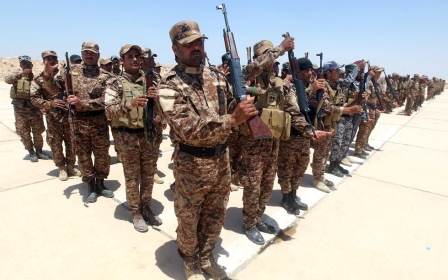Afghanistan-Pakistan IS chief killed in drone strike: officials, militants

The head of the Islamic State group in the Afghanistan-Pakistan region has been killed in a drone strike in eastern Afghanistan, intelligence officials and militant commanders said Saturday.
The National Directorate of Security (NDS), the Afghan spy agency, said Hafiz Saeed was among 30 IS-linked cadres killed in the strike in restive Nangarhar province, close to the Pakistani border, on Friday.
Two IS-affiliated commanders in Afghanistan who said they were present when the strike happened confirmed Saeed's death to AFP.
The IS presence in Afghanistan is still thought to be at an embryonic stage and the killing of Saeed will come as a blow to the group's efforts to establish itself as a serious force.
"Hafiz Saeed, ISIS leader in Afghanistan and Pakistan was killed in a drone strike last night," the NDS said in a statement on Saturday.
"As a result of drone strike in Achin district on gathering place of Daesh, 30 people associated with Daesh including their leader Hafiz Seed were killed."
Daesh is another name for IS.
The two militant commanders, who used to be with the Taliban, speaking to AFP by phone from an undisclosed location, said they were present when the drone strike happened.
The strike took place while a meeting of the commanders was going on, they said, adding that Saeed's badly mutilated body was buried soon afterwards.
It comes less than six months after a drone strike in Afghanistan killed Abdul Rauf Khadim, who was thought to be the IS number two in the country.
On Monday two US drone strikes in Achin targeted suspected IS militants, killing 49 people according to local officials.
Fierce clashes have been reported in recent months between fighters newly aligned with IS and Taliban cadres determined to preserve their dominance.
NATO ended its combat mission in Afghanistan in December, leaving local forces to battle the Taliban alone, but a residual force remains for training and counter-terrorism operations.
A spokesman for US forces in Afghanistan confirmed a "precision strike" was carried out in Nangarhar on Friday but did not give details of the target.
Small, but growing
Saeed was named head of IS's "Khorasan province", which includes Afghanistan, Pakistan and parts of neighbouring countries, in January when a group of Pakistani Taliban switched allegiance to the group.
Since then there have been defections from the Afghan Taliban, with some insurgents apparently adopting the IS flag to rebrand themselves as a more lethal force as NATO troops depart.
The extent of their links to the group's operations in Syria and Iraq, and the extent of the support they receive, is extremely unclear.
IS has grabbed large areas of Syria and Iraq in a brutal campaign but last month the Pentagon said the group's presence in Afghanistan was still "in the initial exploratory phase".
But their presence has clearly rattled the Taliban, who last month wrote to IS leader Abu Bakr al-Baghdadi warning against waging a parallel insurgency in Afghanistan.
The IS Khorasan chapter claimed their first major attack in Pakistan in May, the killing of 43 minority Shiite Muslims on a bus in Karachi.
Afghan President Ashraf Ghani has warned of the threat IS poses to his country as it seeks to end the Taliban's bloody 13-year insurgency.
Russian President Vladimir Putin, who held talks with Ghani at a summit of the Shanghai Cooperation Organisation on Friday, warned IS was "extending its tentacles" into Afghanistan.
Afghan and Taliban negotiators held their first face-to-face talks in Pakistan last week but efforts to find a negotiated path to peace could be complicated if IS becomes a serious threat.
New MEE newsletter: Jerusalem Dispatch
Sign up to get the latest insights and analysis on Israel-Palestine, alongside Turkey Unpacked and other MEE newsletters
Middle East Eye delivers independent and unrivalled coverage and analysis of the Middle East, North Africa and beyond. To learn more about republishing this content and the associated fees, please fill out this form. More about MEE can be found here.




